Introduction
![user posted image]()
![user posted image]()
Today we’re going to look at two of the latest graphic cards released by AMD and Nvidia. Firstly, on the green camp we will have the first Kepler based graphic card, the GTX 680. At its heart is the new GK104 GPU based on the new Kepler architecture manufactured in 28 nm technology. It boasts a whopping 1536 CUDA (Shader) cores, 128 texture units and 32 ROPs. For this review, we will have Galaxy’s reference rendition on the monstrous GTX 680. It clocks in at 1006MHz and also bears a new technology called “Boost Clock” which pushes it up to 1059MHz when more juice is needed. Memory speed clocks in at 1502MHz (6008MHz effective GDDR5), it is equipped with 2GB memory running over a 256-bit memory interface. The card measures around 255mm long which should fit most modern casing just fine. The card looks strangely reminiscent of GTX 580, sporting a rather similar cooling solution which first made its debut in its predecessor.
On the red camp, we will look at Gigabyte’s latest rendition on AMD’s Pitcairn based graphic card. The Pitcairn XT GPU is manufactured on 28nm technology and powers the HD 7870. It boasts 20 Compute Units carrying 1280 Stream Processors, 80 texture units and 32 ROPs. Gigabyte’s HD 7870 OC comes pre-overclocked at 1100MHz, 100 MHz higher than the reference clock. Memory speed remains unchanged at 1200MHz (4800MHz effective GDDR5), it is equipped with 2GB memory running over a 256-bit memory interface. The card measures roughly 260mm long so do make sure that your casing has ample space. As you will later see, the card is equipped with Gigabyte’s trademark triple fan WINDFORCE™3X with “Triangle Cool” technology, which is a customized cooling solution also found in its bigger brother, the Tahiti based HD 7970. Reviews have shown that this is indeed a very efficient and effective cooler.
Kepler GK104 ready and operational
![user posted image]()
Gigabyte’s HD 7870 OC in its full glory
![user posted image]()
P.S: Bear with me as there are no DSLR-quality images here![laugh.gif]()
Test Setup
Hardware
• Processor: Intel Core i7-2600K @ 3.4 GHz
• Mainboard: Intel DZ68DB
• HSF: Cooler Master Hyper 212 Evo
• RAM: Team Elite DDR3 1333MHz RAM (2 X 4GB)
• GPU: Galaxy GTX 680 2GB GDDR5 / Gigabyte HD 7870 OC 2GB GDDR5
• SSD: Kingston SSDNow V100 128GB
• HDD: Samsung SpinPoint F3 1TB
• PSU: Corsair GS600 600W
• Casing: Thermaltake V3 Black Edition
• OS: Windows 7 Home Premium SP1 64-bit
• Monitor: Dell U2312HM 23” Monitor
• Driver: Nvidia 301.10 / AMD Catalyst 12.3
• Softwares: HWMonitor, FRAPS
Game Settings
• Battlefield 3: DX11, 1920 x 1080, 4xMSAA, 16xAF, Ultra Quality
• Batman Arkham City: DX11, 1920 x 1080, FXAA (High), Very High Settings, Tessellation High
• Rage: DX9, 1920 x 1080, 16xAA
• Unigine Heaven 3.0: DX11, 1920 x 1080, 4xAA, 16xAF, Shaders High, Tessellation Extreme
Testing is carried out in a non air-conditioned room.
CPU-Z and GPU-Z screenshots
![user posted image]()
![user posted image]()
Testing
All tests are carried out at the card’s default speed and no overclocking is done.
![user posted image]()
![user posted image]()
![user posted image]()
Conclusion
GTX 680
Wow, where to begin? Firstly, I’ve been bogged down by issues with the GTX 680 since the first day I got it. After installing everything and getting ready to run, the first thing that greeted me was a hideous "red screen of death". Gosh, it drove me nuts. After I did a clean reformat, I manage to trace down the culprit to a software called SoftOSD, it came with the Dell U2312HM monitor. Disabled it from running in msconfig under "Services" tab, then so far no more red screen. If the red screen hinders you from doing anything, you can disable it via the method above from Safe Mode. Hope this info helps for those early adopters of GTX 680 that is facing this issue.
Firstly, this mini review is just to show how two of the latest cards in the market performs respectively and not to compare them together. After all, both are meant to serve in different market segments. As expected, on a 1080p resolution the GTX 680 has no problem at all. Some would even say it’s way overkill. I wished I could have more games to test it out with, but unfortunately gaming is something of a luxury to me these days. The reference cooler on the GTX 680 certainly does its job very well. Idle temperatures are around 43 °C and the highest temperature that I recorded was 82 °C in Battlefield 3. It marks a slight improvement over the GTX 580 which I’ve experienced hitting as high as 89 °C in Battlefield 3. Even while gaming, the fan on the GTX 680 certainly doesn’t sound louder than the casing fans that I have installed. Reviews have also shown that the power consumption also marks an improvement of almost 67W (courtesy of Guru3D) lower than GTX 580.
“The fastest, most efficient GPU ever built”, claims Nvidia. A very bold statement to say the least, but Nvidia has not only lived up to its statement, it has definitely raised the ante with the mighty GTX 680. Availability is another issue however, as these are often in short supplies. Most local sellers only have a handful and I’m lucky enough to land myself with Galaxy’s GTX 680 in time for the review. Priced at around RM1800, this is simply the most powerful single GPU graphics card you could ever put inside your rig. It offers massive performance but it also comes with a massive price tag. Over time as supplies increase, we should see the price for GTX 680 stabilizing and it should be available closer to its initial RRP $499. Oh yes, and for those who are into multi-monitor setup, it can now be done with a single GTX 680, of up to four monitors.
Pros:
• Fastest single GPU card
• Proven cooling solution
• Increased performance/watt over GTX 580
• Allows for multi-monitor setup with just a single card
Cons:
• Pricy
• Low availability at this point of time
HD 7870 OC
So is the HD 7870 a sweet spot 1080p card? Well, you be the judge. It certainly has the muscle to handle today’s latest games with pretty much the highest settings and AA/AF enabled on a 1080p resolution. Cut down on some of those eye candies and the card should fare even better. On Rage, we see the FPS for both HD 7870 and GTX 680 capped at roughly 60 FPS likely due to VSync enabled. Couldn’t figure out how to disable it from the game or AMD’s Catalyst Control Center.![tongue.gif]() Though FPS is subjective from one individual to another, generally anything above 40 FPS is considered “very playable” in my experience. Another thing to note is how effective Gigabyte’s cooling solution is; under intense gaming load, I barely hear anything louder than the Xigmatek XAF fans I have in my casing (front intake and back exhaust), similar case with what I’ve experienced with the GTX 680. But there’s more, it idles at a low of 35 °C and the highest temperature that I recorded was 61 °C in Battlefield 3. Truly impressive. Other reviews have also shown that the Pitcairn based HD 7870 has a very low power consumption, almost 109W (courtesy of Guru3D) lower than GTX 580.
Though FPS is subjective from one individual to another, generally anything above 40 FPS is considered “very playable” in my experience. Another thing to note is how effective Gigabyte’s cooling solution is; under intense gaming load, I barely hear anything louder than the Xigmatek XAF fans I have in my casing (front intake and back exhaust), similar case with what I’ve experienced with the GTX 680. But there’s more, it idles at a low of 35 °C and the highest temperature that I recorded was 61 °C in Battlefield 3. Truly impressive. Other reviews have also shown that the Pitcairn based HD 7870 has a very low power consumption, almost 109W (courtesy of Guru3D) lower than GTX 580.
All said and done, I would say that the HD 7870 is indeed a worthwhile buy. Gigabyte’s model is priced at around RM1195 and it comes with a superb cooling solution, premium components, a healthy factory overclock out of the box and 3 years warranty. Reference clocked models from Sapphire could be gotten from as low as RM1079, so this is definitely a very good and cheaper alternative that one can consider. But note that Sapphire comes with only 2 years warranty. Well, this basically concludes my 1st ever mini review or should I say the field test result for the GTX 680 and HD 7870.![laugh.gif]() I know it's long overdue, but I hope all of you had a good time reading it as I had writing it.
I know it's long overdue, but I hope all of you had a good time reading it as I had writing it. ![smile.gif]()
Pros:
• Handles today's games in 1080p resolution well
• Overclocked out of the box
• Excellent and effective cooling solution
• Low power consumption
Cons:
• Pricier compared to reference clocked models
• Memory speed is not pre-overclocked
Rev 1.0 – 17 Apr 12
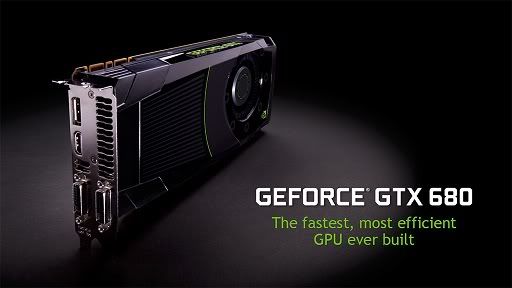
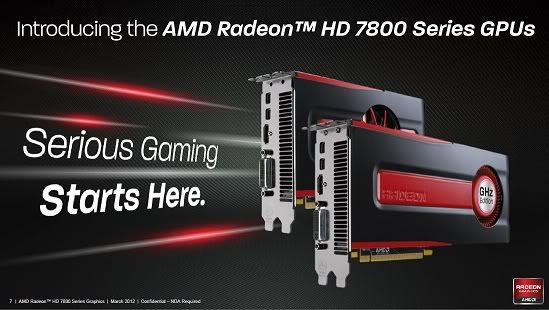
Today we’re going to look at two of the latest graphic cards released by AMD and Nvidia. Firstly, on the green camp we will have the first Kepler based graphic card, the GTX 680. At its heart is the new GK104 GPU based on the new Kepler architecture manufactured in 28 nm technology. It boasts a whopping 1536 CUDA (Shader) cores, 128 texture units and 32 ROPs. For this review, we will have Galaxy’s reference rendition on the monstrous GTX 680. It clocks in at 1006MHz and also bears a new technology called “Boost Clock” which pushes it up to 1059MHz when more juice is needed. Memory speed clocks in at 1502MHz (6008MHz effective GDDR5), it is equipped with 2GB memory running over a 256-bit memory interface. The card measures around 255mm long which should fit most modern casing just fine. The card looks strangely reminiscent of GTX 580, sporting a rather similar cooling solution which first made its debut in its predecessor.
On the red camp, we will look at Gigabyte’s latest rendition on AMD’s Pitcairn based graphic card. The Pitcairn XT GPU is manufactured on 28nm technology and powers the HD 7870. It boasts 20 Compute Units carrying 1280 Stream Processors, 80 texture units and 32 ROPs. Gigabyte’s HD 7870 OC comes pre-overclocked at 1100MHz, 100 MHz higher than the reference clock. Memory speed remains unchanged at 1200MHz (4800MHz effective GDDR5), it is equipped with 2GB memory running over a 256-bit memory interface. The card measures roughly 260mm long so do make sure that your casing has ample space. As you will later see, the card is equipped with Gigabyte’s trademark triple fan WINDFORCE™3X with “Triangle Cool” technology, which is a customized cooling solution also found in its bigger brother, the Tahiti based HD 7970. Reviews have shown that this is indeed a very efficient and effective cooler.
Kepler GK104 ready and operational
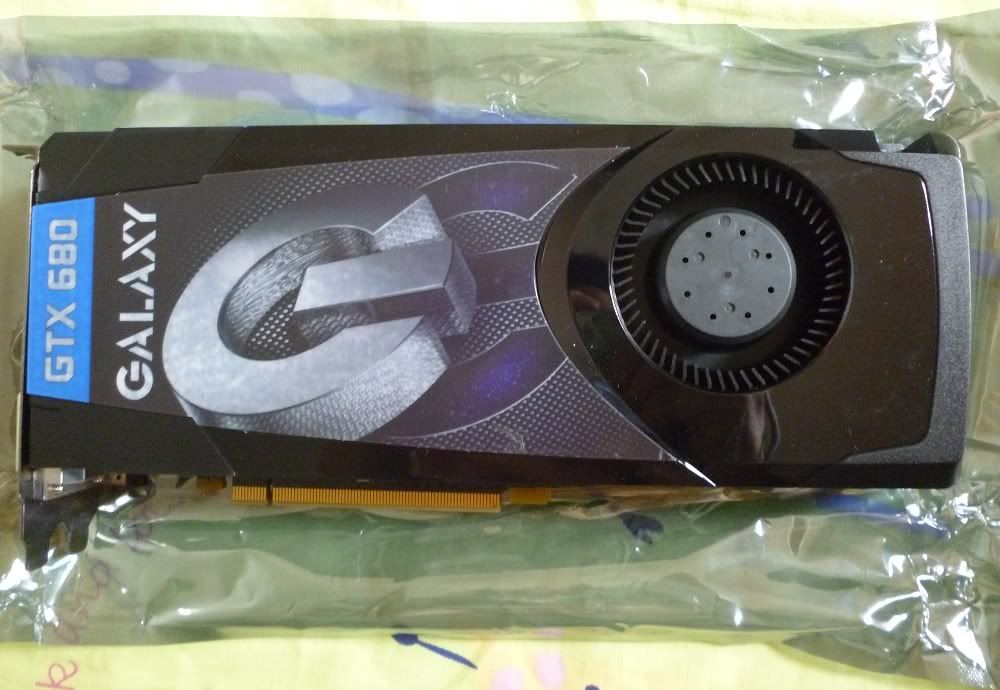
Gigabyte’s HD 7870 OC in its full glory
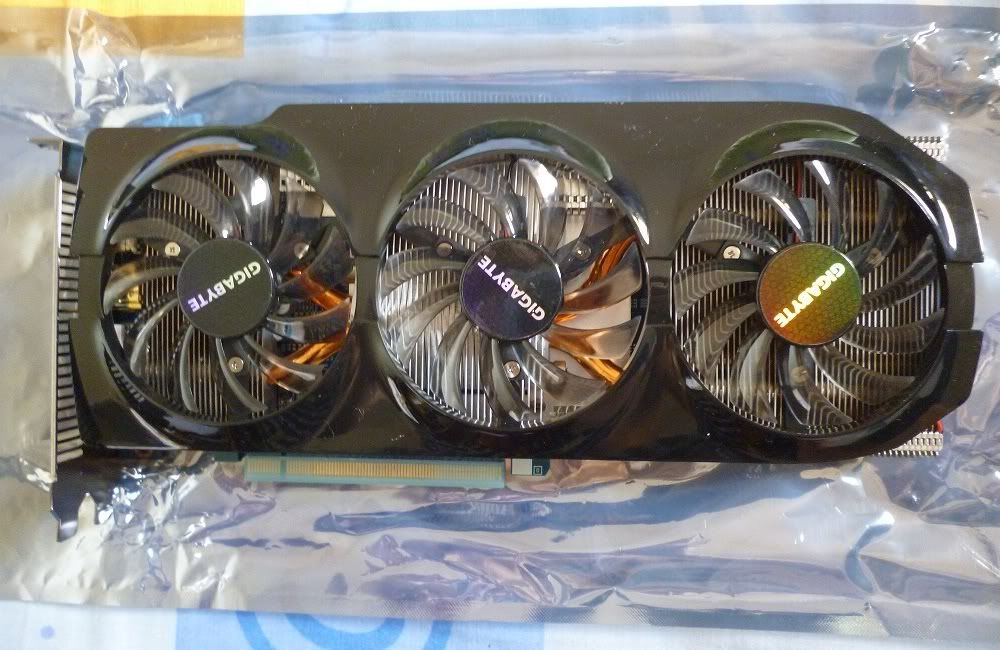
P.S: Bear with me as there are no DSLR-quality images here
Test Setup
Hardware
• Processor: Intel Core i7-2600K @ 3.4 GHz
• Mainboard: Intel DZ68DB
• HSF: Cooler Master Hyper 212 Evo
• RAM: Team Elite DDR3 1333MHz RAM (2 X 4GB)
• GPU: Galaxy GTX 680 2GB GDDR5 / Gigabyte HD 7870 OC 2GB GDDR5
• SSD: Kingston SSDNow V100 128GB
• HDD: Samsung SpinPoint F3 1TB
• PSU: Corsair GS600 600W
• Casing: Thermaltake V3 Black Edition
• OS: Windows 7 Home Premium SP1 64-bit
• Monitor: Dell U2312HM 23” Monitor
• Driver: Nvidia 301.10 / AMD Catalyst 12.3
• Softwares: HWMonitor, FRAPS
Game Settings
• Battlefield 3: DX11, 1920 x 1080, 4xMSAA, 16xAF, Ultra Quality
• Batman Arkham City: DX11, 1920 x 1080, FXAA (High), Very High Settings, Tessellation High
• Rage: DX9, 1920 x 1080, 16xAA
• Unigine Heaven 3.0: DX11, 1920 x 1080, 4xAA, 16xAF, Shaders High, Tessellation Extreme
Testing is carried out in a non air-conditioned room.
CPU-Z and GPU-Z screenshots
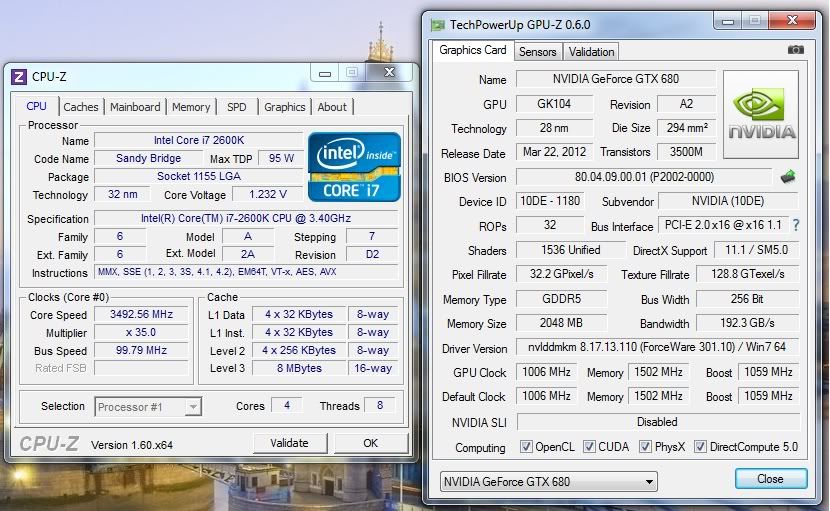

Testing
All tests are carried out at the card’s default speed and no overclocking is done.

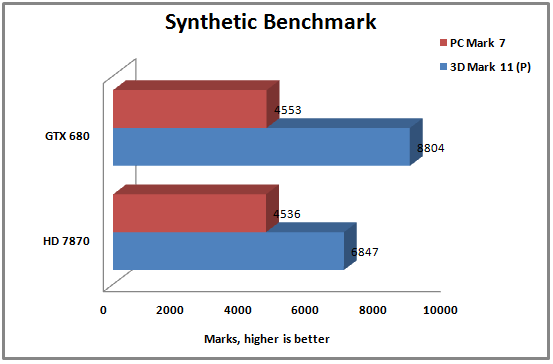
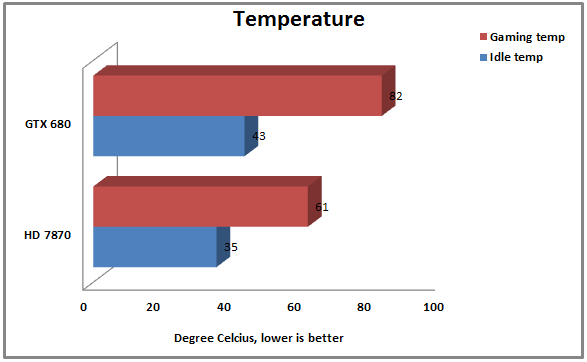
Conclusion
GTX 680
Wow, where to begin? Firstly, I’ve been bogged down by issues with the GTX 680 since the first day I got it. After installing everything and getting ready to run, the first thing that greeted me was a hideous "red screen of death". Gosh, it drove me nuts. After I did a clean reformat, I manage to trace down the culprit to a software called SoftOSD, it came with the Dell U2312HM monitor. Disabled it from running in msconfig under "Services" tab, then so far no more red screen. If the red screen hinders you from doing anything, you can disable it via the method above from Safe Mode. Hope this info helps for those early adopters of GTX 680 that is facing this issue.
Firstly, this mini review is just to show how two of the latest cards in the market performs respectively and not to compare them together. After all, both are meant to serve in different market segments. As expected, on a 1080p resolution the GTX 680 has no problem at all. Some would even say it’s way overkill. I wished I could have more games to test it out with, but unfortunately gaming is something of a luxury to me these days. The reference cooler on the GTX 680 certainly does its job very well. Idle temperatures are around 43 °C and the highest temperature that I recorded was 82 °C in Battlefield 3. It marks a slight improvement over the GTX 580 which I’ve experienced hitting as high as 89 °C in Battlefield 3. Even while gaming, the fan on the GTX 680 certainly doesn’t sound louder than the casing fans that I have installed. Reviews have also shown that the power consumption also marks an improvement of almost 67W (courtesy of Guru3D) lower than GTX 580.
“The fastest, most efficient GPU ever built”, claims Nvidia. A very bold statement to say the least, but Nvidia has not only lived up to its statement, it has definitely raised the ante with the mighty GTX 680. Availability is another issue however, as these are often in short supplies. Most local sellers only have a handful and I’m lucky enough to land myself with Galaxy’s GTX 680 in time for the review. Priced at around RM1800, this is simply the most powerful single GPU graphics card you could ever put inside your rig. It offers massive performance but it also comes with a massive price tag. Over time as supplies increase, we should see the price for GTX 680 stabilizing and it should be available closer to its initial RRP $499. Oh yes, and for those who are into multi-monitor setup, it can now be done with a single GTX 680, of up to four monitors.
Pros:
• Fastest single GPU card
• Proven cooling solution
• Increased performance/watt over GTX 580
• Allows for multi-monitor setup with just a single card
Cons:
• Pricy
• Low availability at this point of time
HD 7870 OC
So is the HD 7870 a sweet spot 1080p card? Well, you be the judge. It certainly has the muscle to handle today’s latest games with pretty much the highest settings and AA/AF enabled on a 1080p resolution. Cut down on some of those eye candies and the card should fare even better. On Rage, we see the FPS for both HD 7870 and GTX 680 capped at roughly 60 FPS likely due to VSync enabled. Couldn’t figure out how to disable it from the game or AMD’s Catalyst Control Center.
All said and done, I would say that the HD 7870 is indeed a worthwhile buy. Gigabyte’s model is priced at around RM1195 and it comes with a superb cooling solution, premium components, a healthy factory overclock out of the box and 3 years warranty. Reference clocked models from Sapphire could be gotten from as low as RM1079, so this is definitely a very good and cheaper alternative that one can consider. But note that Sapphire comes with only 2 years warranty. Well, this basically concludes my 1st ever mini review or should I say the field test result for the GTX 680 and HD 7870.
Pros:
• Handles today's games in 1080p resolution well
• Overclocked out of the box
• Excellent and effective cooling solution
• Low power consumption
Cons:
• Pricier compared to reference clocked models
• Memory speed is not pre-overclocked
Rev 1.0 – 17 Apr 12